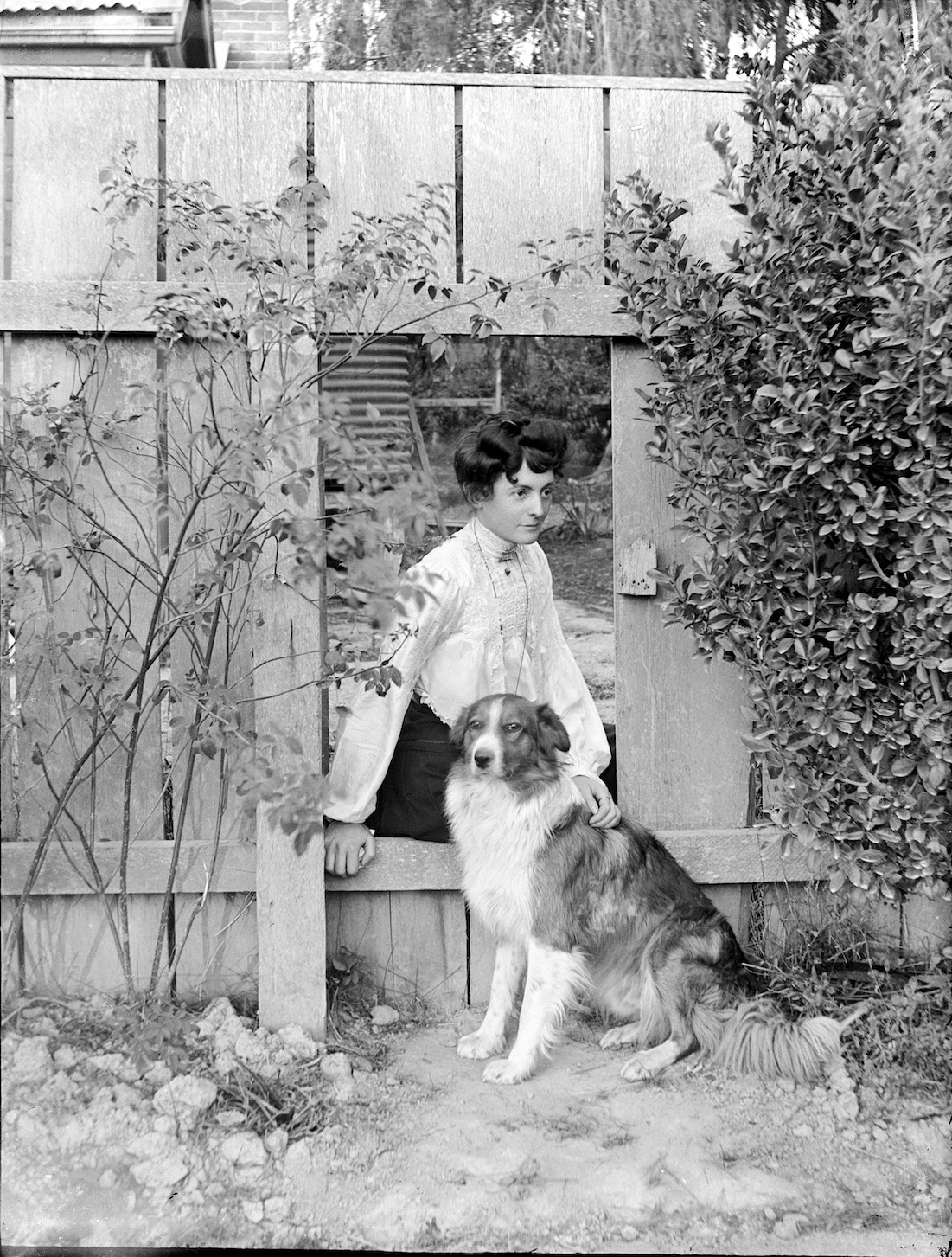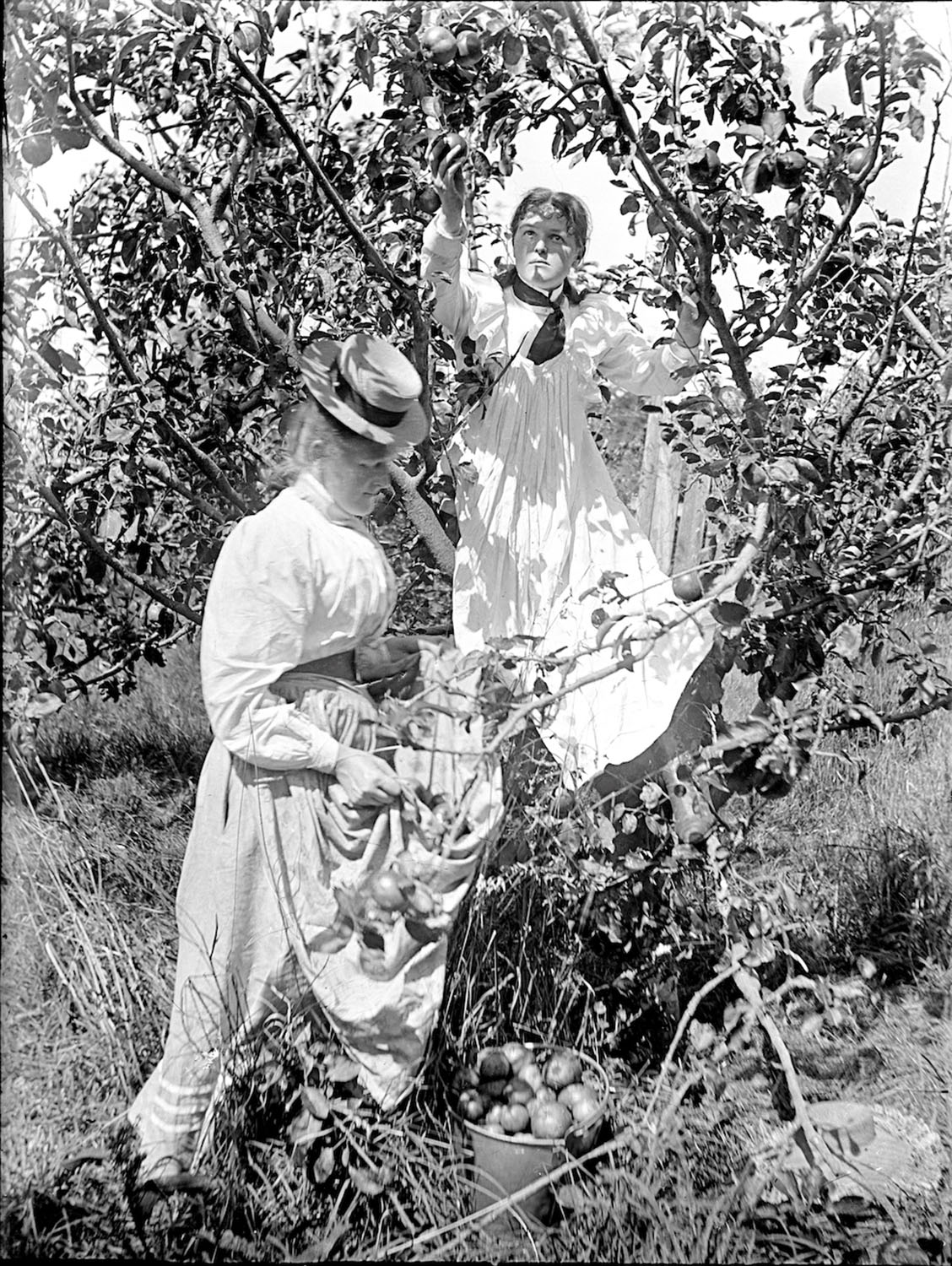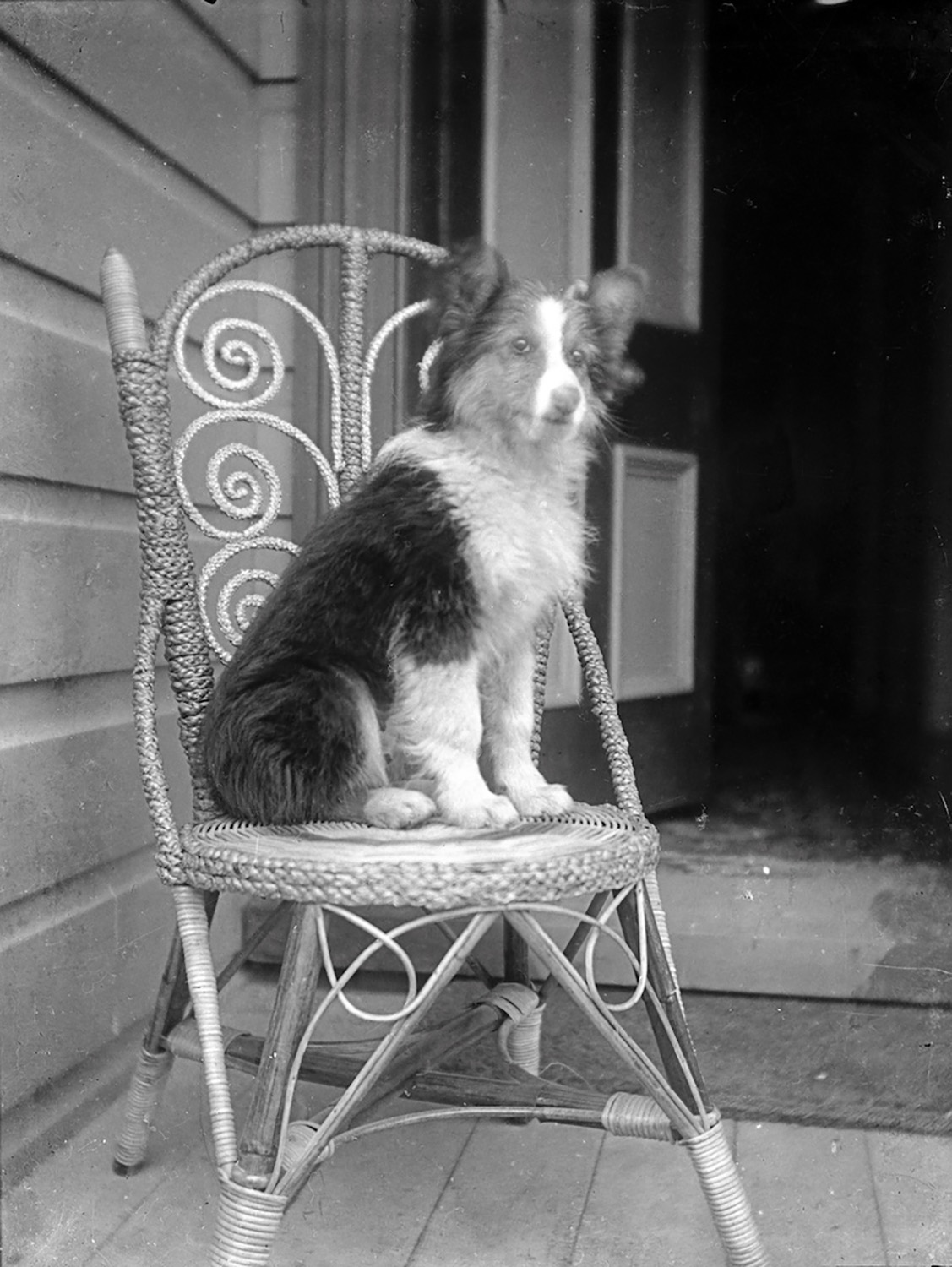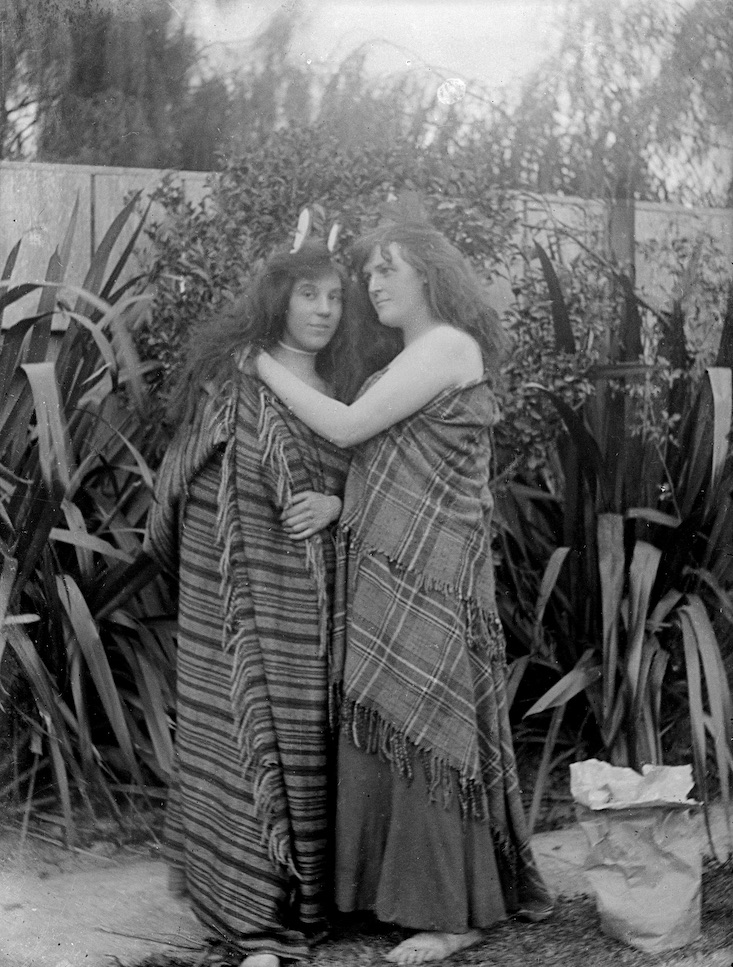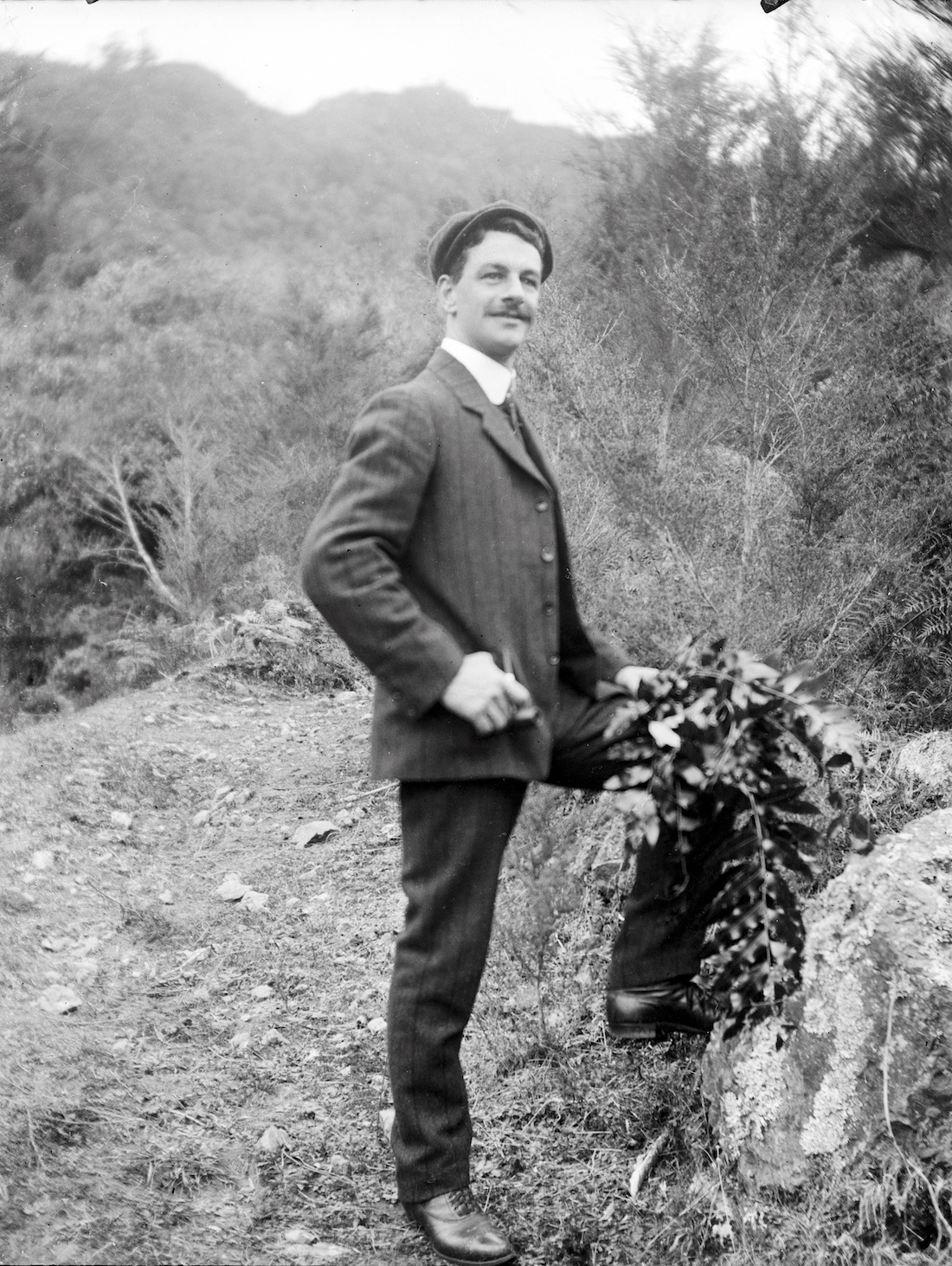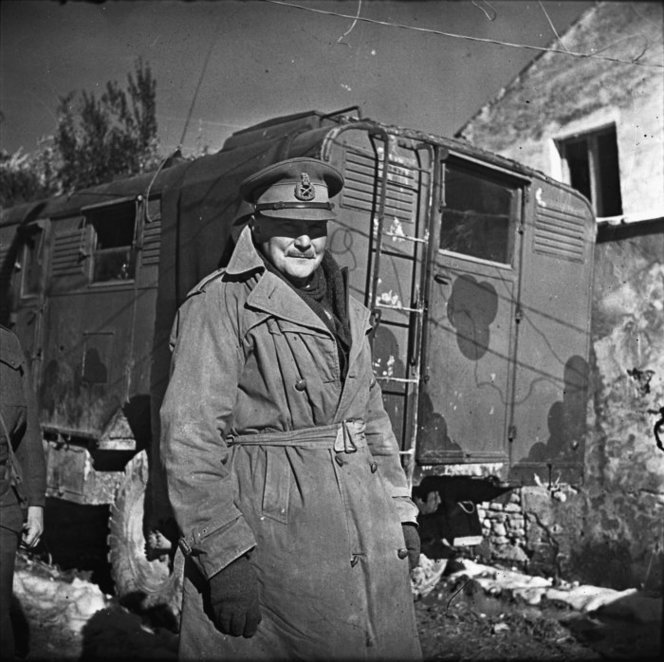This Edwardian Life: Lost Photographs
This Edwardian Life: Lost Photographs
Lemuel Lyes
August, 2019
Lemuel Lyes is an historical archive researcher and producer for the television industry, based in New Zealand but working on many international productions. He is a self-described history geek and maintains the History Geek website, where this article was originally published. We reproduce it in full here with the generous permission of Lemuel Lyes and other copyright holders .
This is the story behind a remarkable collection of photographs that remained hidden for over a century. Glass plate negatives with forgotten scenes of everyday life in Edwardian New Zealand. It is also the story of my personal quest to discover who was behind the lens – the man or woman who was such a talented photographer and captured such candid and beautiful views. Through their eyes these images really are a window into another world. I hope you enjoy them as much as I do.
I’m a collector of vintage photography and last year I purchased this collection of glass plate negatives from a dealer who had bought them at an estate auction in Christchurch. Sadly they came without any provenance and without any indication of where they came from or who the photographer might’ve been. I took the collection on as a project to scan, restore and research in my spare time. I underestimated how long it would take – and also how rewarding it would be. The photographs are absolutely stunning.
Woman posing with dog, likely taken in the North Island, New Zealand, circa 1907-1911. Lemuel Lyes Collection.
Firewood is sorted. Man posing with dog and axe. New Zealand (possibly in Fielding) circa 1907-11. Lemuel Lyes Collection.
Woman relaxing with a book, Te Aroha, New Zealand, circa 1907-1911. Lemuel Lyes Collection.
Women picking fruit. Likely North Island, New Zealand circa 1907 – 1911. Lemuel Lyes Collection.
They were taken during the Edwardian era – which in the strictly regal sense covers the reign of King Edward VII from 1901 – 1910, but I prefer the description that encapsulates a broader period from the late-nineteenth century through until the start of the First World War. The French call this the Belle Époque, meaning the ‘beautiful era’. This was a time when societal changes, economic prosperity and technology offered promise and opportunity, but for so many those hopes and dreams came to a tragic end in the most devastating war the world had ever seen. Rural New Zealand was about as far away as you could possibly get from Paris and London, but the world was more connected than ever before and in some ways New Zealanders were at the forefront of change – women here had already won the right to vote. The invention and proliferation of the bicycle was part of this revolution, a tool for mobility and independence.
Woman posing with bicycle. New Zealand circa 1907-1916. Lemuel Lyes Collection.
This collection of photographs also beautifully captures the evolution of fashion, interior decor, gardens, recreation, and also the rise of the tourism industry in New Zealand’s iconic thermal regions. Many of the photographs were taken in Te Aroha and Rotorua.
As I scanned the plates and one by one the images came to life in such detail I realised that this collection was something very special. This photographer wasn’t just taking the usual family portraits but was actively documenting their everyday life; their picnics and travels, their home and garden, their pets and even their domestic chores, yet as candid as these views seem the photographer had also carefully considered the composition of each scene and directed the subjects accordingly. There was real thought and talent put into these photographs – it seemed a shame that they hadn’t been seen until now – and even more of a shame that the identity of the photographer was unknown. So I set out to try to change that.
Man pretending to help with the laundry (look at his hands), New Zealand circa 1907-1916. Lemuel Lyes Collection
Extremely good boy or girl. Very still. That’s it. Lots of treats for you. Dog on chair, New Zealand circa 1907-1916. Lemuel Lyes Collection.
Young girl and dog dwarfed by seriously impressive Edwardian produce, New Zealand circa 1907-1916. Lemuel Lyes Collection.
Some next level shenanigans at an Edwardian picnic in the New Zealand bush, likely North Island circa 1907-1911. Lemuel Lyes Collection.
There are brief descriptions written on some, but not all, of the negative boxes which helped identify some of the locations, but most the photographs have been jumbled up so it took some work to figure out which descriptions match which photograph – and many had no descriptions at all. There were also some identifiable landmarks, which helped me figure out where some of the photographs were taken.
Many of them show scenes in and around the rural town of Te Aroha, in the Waikato region of the North Island. The hot springs and domain here were a popular tourist destination – especially after the Cadman Bathhouse opened in 1898. These beautiful photographs show Te Aroha at the height of this early tourism boom. Many of these buildings are still standing today; in fact it is the most complete Edwardian Domain anywhere in New Zealand.
Cadman Bath House, Te Aroha, New Zealand, circa 1907-1911. Lemuel Lyes Collection.
No. 8 Spring, Te Aroha, New Zealand, circa 1907-1911. Lemuel Lyes Collection.
Perhaps a Te Aroha local took the photographs – but on the other hand they could’ve just as easily been taken by one of the thousands of tourists who travelled here by train to enjoy a leisurely holiday filled to brimming point with sparkling water, lawn bowls and relaxation. Other photographs in the collection were taken at other geothermal attractions, including Ōhinemutu, Whakarewarewa, Rotomohana and Waimangu.
Suspect this is the Waimangu Volcanic Valley, North Island, New Zealand, circa 1907-1911. Lemuel Lyes Collection.
Had the photographer been at Waimangu just a year or two earlier then they might’ve witnessed what was at the time the largest geyser anywhere in the world. Between 1900 and 1904, eruptions at the Waimangu Geyser were observed reaching an unbelievable height of up to 1 500 feet (460 metres). A landslide weakened these eruptions in 1904 and the geyser became extinct by 1908. Another even more legendary attraction that the photographer missed out on was the Pink and White Terraces, which were destroyed by the eruption of Mt. Tarawera in 1886. Despite the loss of this natural wonder, the site of the eruption, especially the buried village of Te Wairoa, was popular with Edwardian tourists – including our photographer. This image shows a group heading to Te Wairoa.
Edwardian tourists visiting Te Wairoa, circa 1907-1911. Lemuel Lyes Collection.
As well as the geothermal attractions, the opportunity to experience Māori culture was another major drawcard to the region.
The iconic waharoa (entranceway) at Whakarewarewa, Rotorua, circa 1907-1911. Lemuel Lyes Collection.
A visit to a hāngi pit, I suspect this is at Ōhinemutu, Rotorua circa 1907-1911. Lemuel Lyes Collection.
Our photographer seemed particularly enamoured by the Māori culture they encountered; some photographs in the collection show ways that they appreciated and even adopted it back home. Perhaps the most jarring example is this backyard cultural appropriation.
Dress ups in the backyard, New Zealand circa 1907-1911. Lemuel Lyes Collection.
Some of the images were also taken at a house named ‘Tena Koe’ – possibly the home of the photographer – the tradition of naming your residence was more common back then than it is now.
Woman and child seated below ‘Tena Koe’ sign at entrance to home. Likely photographed in Christchurch, New Zealand, circa 1911-1916. Lemuel Lyes Collection.
As I worked through the collection one of the challenges was to try to narrow down the possible date range that the images were taken. The fashion, technology, street scenes and landmarks all suggested that they were taken around the late-Edwardian era. There were also clues on some of the slips of protective paper that had been placed between the glass plate negatives. Some of the scraps have dates, the earliest I found was an unused diary page from February 1908 and the latest was torn from the Lyttelton Times dated 22 April 1916. Of course this doesn’t mean that the photographs were necessarily taken between these dates but it adds to the bigger picture.
St Faith’s Church, Ōhinemutu, Rotorua, circa 1907-1910. Lemuel Lyes Collection.
There were other clues in some of the photographs as well. This one of St Faith’s Church in Ōhinemutu must’ve been taken before it was relocated in 1910 to make way for a replacement church (the original church survived as a sunday school and church hall until it was destroyed by the 1936 cyclone – one of the worst storms to hit New Zealand in recorded history).
One of the photographs has a date etched onto it – 4/1/11.
Picnic by the water, 4th January 1911. Suspect this is Lyttelton Harbour from Governor’s Bay, South Island, New Zealand. Lemuel Lyes Collection.
As I worked through the collection I gradually began to get a better sense of where and when the photographs were taken, but there was still a frustrating lack of any clues to help me identify the photographer. In fact I had scanned over one hundred and fifty of them and there was only a few dozen left to go when finally I had the major breakthrough that I had nearly given up hoping for.
Dog resting on porch. Circa 1907 – 1916. Lemuel Lyes
Detail of previous image. Sign next to door. Lemuel Lyes Collection.
At last I had a name. J. W. Campbell. Dentist.
I was able to locate a J. W. Campbell who passed his dental examinations in 1907, and by 1908 he was practising at Te Aroha – the location that features so prominently in this collection of photographs. His full name was James Wishart Campbell.
Ohinemuri Gazette, Volume XVIV, Issue 2415, 26 October 1908. Courtesy of Papers Past.
James was born on 23 June 1873 at Tezpur, Assam, India. He was educated in Scotland and in 1892 joined the 2nd Regiment, Scots Guards. After a few years in the military he resigned and immigrated to New Zealand, working as a farmhand, then in a foundry and eventually as a dentist’s apprentice. In 1906 he married Minnie Elizabeth Chamberlain in Christchurch. Around this time he was working as a dental assistant in Rangiora. The following year he passed his dental examinations and sometime around 1907-1908 he moved to Te Aroha to work as a dental surgeon for A L Yule. It appears that James worked at the Te Aroha branch, while Yule was based in Paeroa and visited Te Aroha on a weekly basis. On at least one occasion James also covered for Yule at the Paeroa practise.
At some stage in 1911, James finished working in Te Aroha and moved back south to Christchurch. He shows up in electoral rolls in both those places that year.
I finally had a name – and it was a promising lead – but there was still a lot of work to do to confirm if James was the photographer or not. All I really knew at this stage was that one of the photographs was taken at the residence of J. W. Campbell, who worked for a few years in Te Aroha, where a significant number of the photographs in the collection were taken, but was he the photographer? Perhaps it was a family member or friend? Or even a passerby that liked the look of his house? Creepy, but a possibility. So I went back through all the photographs, one by one, looking for any other clues that might help.
I noticed that one of the descriptions scrawled on a box was “Bowling Green – Min”. Min didn’t mean anything to me initially – but now I wondered if maybe it was referencing Minnie.
Bowling green at Te Aroha Domain, circa 1907-1911. Minnie Campbell née Chamberlain watching the game. Lemuel Lyes Collection.
There was only one photograph of a bowling green in the collection, taken at the Te Aroha Domain. In the foreground you can see a woman relaxing on a bench – a woman who appears in numerous photographs throughout the collection. I suspect this is likely his wife Minnie.
There was also a clue in this image:
Chamberlain Bros. warehouse in Fielding, New Zealand, circa 1907-1911. Lemuel Lyes Collection.
The sign reads ‘Chamberlain Bros. Cornelius Roller Flour. Fielding’. Minnie’s maiden name was Chamberlain and through genealogical research I was able to confirm that some of her family were living in Fielding at around the same time that James and Minnie were living in Te Aroha.
Then there are the scraps of paper used between the negatives. They may have been placed there months or even years after the plates were developed, but they are still a useful part of the puzzle. Several scraps are from Christchurch newspapers – and we know that James had moved back there by then. This seems to further support the theory that James was the photographer.
Then while looking closely through the images another detail jumped out from the background clutter in a workshop scene.
Two men in workshop. Unknown location in New Zealand, circa 1907-1916. Lemuel Lyes Collection.
Close up of dentures in workshop.
Close up of dentures in hand.
The photographer appears to have had behind the scenes access to a dentist’s workshop…
Several more clues emerged when I checked to see if James served during the First World War. He had previous military experience but was 41 years old when war broke out, likely too old to be called up to fight in the trenches, however despite his age he was still registered on the 1916-17 Reserve Rolls as a dental surgeon. Looking into his military service provided me with additional verification of his Christchurch address and there was also another surprise – James had been listed as next of kin by his brother Frederick William Campbell, who embarked with the 27th Reinforcements in mid-1917. The Auckland War Memorial Museum has a portrait of Fred and I immediately recognised him – he appears in several of the photographs. The name Fred also appears in some of the written descriptions on the boxes.
Full length portrait of Lance Corporal Frederick William Campbell, Reg No 49766, of the Auckland Infantry Regiment, A Company, 27th Reinforcements. Sir George Grey Special Collections, Auckland Libraries, 31-C3598
Outdoors portrait of Frederick William Campbell, New Zealand circa 1907-1916. Lemuel Lyes Collection.
Then there was the mysterious name ‘Roma’ scrawled on a box filled with photographs of a beautiful baby. James and Minnie had only one child – a daughter named Roma Aroha Campbell. It would be kind of weird to take dozens of photographs of someone else’s baby, right?
Young baby, believed to be Roma Aroha Campbell. Possibly around 1911. Lemuel Lyes Collection
The evidence was coming together. Then there was one more clue – after leaving Te Aroha, James lived in a villa at 582 Madras St, Christchurch. Remarkably the villa has survived the last century (not to mention several rollicking earthquakes) and was recently on the market. I was able to recognise the villa on both Google Street View and on the real estate website as one that features prominently in the collection of photographs – this was the ‘Tena Koe’ house.
The ‘Tena Koe’ house, Madras Street, Christchurch, circa 1911-1916. Lemuel Lyes Collection
So putting all the pieces together, while I’d still love for some definitive confirmation that it wasn’t a friend or family member, it seems extremely likely that James Wishart Campbell was the photographer and that most of these photographs were taken by him during his time working as a dental surgeon at Te Aroha, with others taken during trips further afield including to Rotorua and Fielding, likely between the years 1907-1911, with some of the scenes likely taken later in Christchurch from 1911 onward, possibly through to as late as 1916. The photographs stop here – but things were about to get a little interesting for James.
In December 1916 two shadowy figures were spotted skulking through St. Albans Park in Christchurch. The world was at war, and it seemed that enemy agents were on the loose. A horrified onlooker watched as the secret agents scurried from tree to tree, liberating what appeared to be flies, most likely infected with a viral disease. Biological warfare had reached New Zealand’s suburbs. At least, that’s what the concerned member of the public reported to the local police.
A sergeant tracked the offenders down only to discover that they weren’t secret agents and they weren’t releasing flies at all, they were trying to catch them. James Campbell had found a new hobby – he was a member of the Christchurch Microscopical Society and along with Mr. C. B. Morris he had been catching flies in St. Albans Park for examination and classification. James had caught the bug-catching bug. He was an amateur entomologist.
After returning to Christchurch from his stint in Te Aroha, James appears to have embraced the opportunities the city gave to pursue his interests. By July 1914 he was the secretary of the New Zealand Rationalist Association, which met at the Caledonian Hall, Worcester St. Then on 21 July 1916 it was announced that he would give a talk at the Canterbury Microscopical Society on Hydra Viridis (freshwater polyps). Five months later he was involved in the unfortunate fly-catching escapade at St Albans Park, but not letting that minor brush with the law deter him he continued his pursuit. By February 1917 he was elected onto the committee of the society and in July he read a paper on sea squirts, showing a number of slides to illustrate them. The use of slides appears to have been of particular interest to him, later that year he suggested that the society form an entomological collection as well as a microscopic slide library and in March 1918 he exhibited a series of micro-lantern slides illustrating the different anatomical parts of a beetle. Perhaps some of his experience as an amateur photographer came in handy in the preparation and display of these slides.
He was starting to gain a reputation for his entomological work and was amassing an incredible collection of New Zealand moths, butterflies, flies and other insects. He gave a talk on his collection in June 1919 and that summer he undertook an expedition to Arthur’s Pass, which has been described to me as a cornerstone in New Zealand entomology. His discoveries that summer included a cicada that was named in his honour – Maoricicada campbelli.
James continued his trade as a dentist, but it was his passion for New Zealand entomology that he really drilled into. His contribution to that field is his most notable legacy – he continued to collect specimens over the following decades and corresponded with well-known entomologists all over the world. There are at least eight species that have been named after him.
Some of his specimens and slides survive today at the Canterbury Museum, who have kindly allowed me to reproduce some examples.
Chalastra pellurgata moth. Collected 15 October 1929. James Wishart Campbell collector. Canterbury Museum
Aedeus antipodeus mosquito. Collected 11 June 1922. James Wishart Campbell collector. Canterbury Museum
It seems appropriate that included among these specimens are some flies – however none appear to be from his eventful expedition to St Albans Park in 1916.
Five slides with wings or hypopygium of crane flies mounted. Collected Governors Bay and Purua 1921 – 1923. James Wishart Campbell collector. Canterbury Museum
James Campbell passed away in Christchurch on 24th October 1956. His daughter Roma married, but I haven’t been able to find any records of her having had any children. She passed away in Christchurch on 24th September 1985. I’ve endeavoured to locate any relatives but have reached the conclusion that there don’t appear to be any living descendants – the closest I’ve been able to locate so far are some distant cousins. I’d love to hear from anyone with a connection to either the Campbell or Chamberlain families, especially anyone who might be able to recognise any of the people in the images.
Perhaps James stopped pursuing photography sometime between 1911 – 1916 and shifted his focus to entomology instead. Or maybe he ‘upgraded’ to a box brownie, popular at the time, switching to film negatives, which sadly lack the permanence of glass plates. Photograph albums and film negatives are regularly thrown out without any thought, especially after the owner passes away – I’ve heard far too many horror stories about photos of great historical value being burned or taken to the tip – but glass plate negatives often seem to be survivors. It seems contradictory as they are such fragile objects, vulnerable to being fractured or shattered in a moment of carelessness or seismic misfortune, yet I suspect their physical presence gives them a sort of reverence that can sometimes save them from being disposed of – instead they are often tucked away in the corner of an attic, kept by friends of the family, or even strangers, and eventually they sometimes end up at auction houses or antique shops.
One mystery I haven’t been able to solve is whether or not James features in any of the images. I haven’t been able to find any confirmed photographs of him from any other source to compare to. So sadly, I don’t know what he looked like. The strongest clue is that the name Jim appears in a few descriptions on the boxes – it is a common name so I can’t be sure, but it could well refer to James Campbell. This might be him here. That’s my best guess at this stage.
Man with baby. Possibly James and Roma Campbell. Bonus dog and toy monkey. New Zealand circa 1907-1916. Lemuel Lyes Collection.
It seems likely that if you were rocking around with a camera that you’d step in front of it once in a while, so I’m pretty sure James is there somewhere. I’m hoping that perhaps after publishing this article someone might come forward with another photograph I could use for comparison.
There might also be someone else of interest lurking in one of these photographs. Just a week before finishing this article a friend alerted me to a remarkable coincidence. At around the time that James finished working in Te Aroha as a dental surgeon, his employer hired another assistant. A young chap called Bernard had been admitted to the Dentist’s Register of New Zealand on 22 May 1911 and his first job was working for A. L. Yule. The specific details are a little shaky, but it is believed he worked for Yule’s Morrinsville practise – not far from Te Aroha.
Bernard Cyril Freyberg standing beside truck. New Zealand. Department of Internal Affairs. War History Branch :Photographs relating to World War 1914-1918, World War 1939-1945, occupation of Japan, Korean War, and Malayan Emergency. Ref: 1/4-019536-F. Alexander Turnbull Library, Wellington, New Zealand. /records/23183506
Bernard was a competitive swimmer and in early 1912 famously swam down the Waihou River from Te Aroha to Paeroa, a distance of around 22 kilometres. Three years later he made an even more impressive swim, this time in the Gulf of Saros to light flares in an attempt to distract Ottoman forces from the Allied landings at Gallipoli. He was awarded the Distinguished Service Order for this act of heroism – and was later awarded the Victoria Cross for another act of gallantry. At the outbreak of the Second World War he was appointed as commander of the 2nd New Zealand Expeditionary Force, which he led through Greece, Crete, Africa and Italy. Bernard Freyberg is remembered as New Zealand’s most distinguished soldier and military leader – and he started out working as an assistant for the same dentist that employed James Campbell. Yes, this country really is that small.
I’m not sure exactly when James left his position working for Yule, and I’m also not sure exactly when Bernard started – so I don’t know if the two of them ever crossed paths or not. It is a possibility; although I wonder if perhaps a more likely explanation is that perhaps Yule hired Bernard as a replacement when James returned to Christchurch. Needless to say though, when I became aware of this coincidence I went back through all the photographs again – one by one – checking just in case a young Freyberg could be seen larking about at one of the picnics or perhaps even captured mid-swim in one of the photographs of the Waihou River. I haven’t been able to spot him yet, but maybe just maybe he is there somewhere – keep an eye out just in case.
It has been a real privilege and delight to bring this collection back to life and rediscover these lost glimpses of Edwardian New Zealand, and I’m thrilled to have finally been able to restore at least some of the provenance behind them. There are far too many photographs in this collection to share in one post, nearly two hundred in total, and I want to make as many of them publicly available as possible, so my intention is to share more images throughout the year in a series of posts exploring different themes and places. There are lots of stories still to tell. If that sort of thing interests you then click the subscribe button over on the right – I think – it’s there somewhere.
In case anyone has an interest in the technical process involved in scanning these images, I’ve been using a Epson Perfection V800 Scanner with SilverFast 8 to scan the glass plates and have been restoring them using Pixelmator. Here is a useful guide to get you started on how to scan glass plate negatives.
There are a huge number of people who have helped me during the research into this collection, far too many to list them all, but I do want to give a special shout-out to Darian Zam, Peter Johns, Canterbury Museum and the lovely folks at the Te Aroha Museum. Thanks also to everyone who has followed the story of this collection on Facebook and Twitter – especially to those who have been so generous with their knowledge and expertise in all sorts of fields, helping to identify important details in the photographs that I would have otherwise missed. If you have more information about any of the places or people in the photographs then I’d love to hear from you.
© Lemuel Lyes

